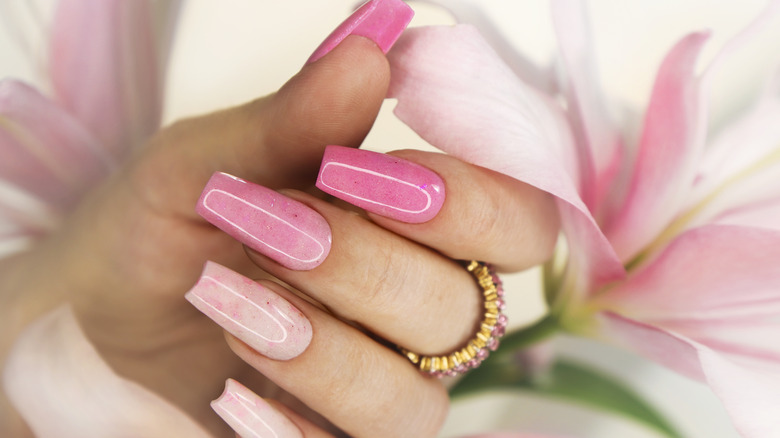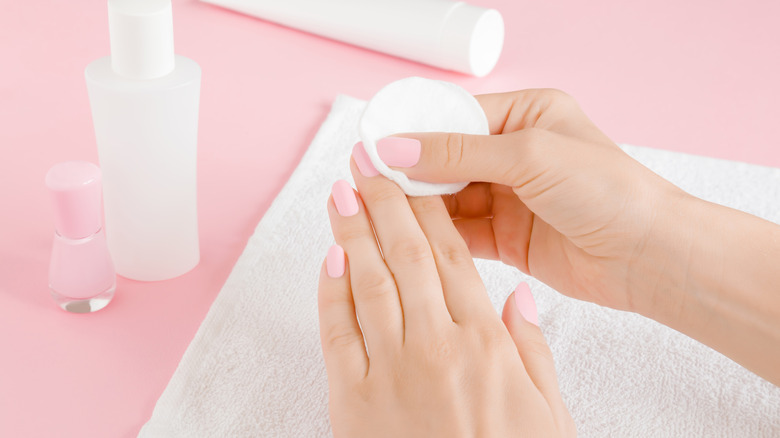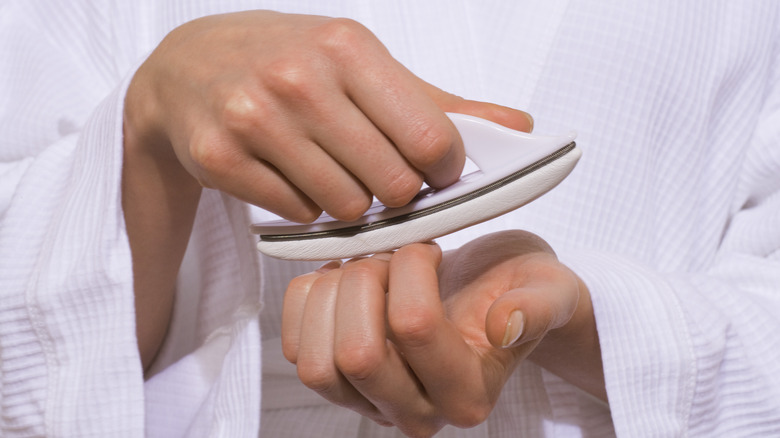The Simple Two-Step Process To Make Press-On Nails Last For Days
While at-home manicures can absolutely save time and money, professionals know a few tricks that the rest of us don't often know to employ when we do our own nails. If you plan to get a manicure at a salon, you usually need to dedicate a significant part of your day to doing so, as professionals use multiple techniques to not only provide a relaxing experience, but also to ensure a long-lasting, beautiful set of nails.
Between soaking of the fingertips, exfoliation, hand massage, cuticle softening and removal, and then each step involved with the painting of nails or the application of false nails (via Health and Style), you're often looking at over an hour per appointment. And while you might choose to skip some of these steps when performing an at-home manicure, it turns out that some of the tricks nail technicians use should absolutely be incorporated into your do-it-yourself mani if you want to get professional-looking, long-lasting results.
For instance, if you are applying press-on nails or stick-on polish, there are two steps you absolutely should not skip: dehydrating your nails and buffing them.
Dehydrating your nails
While dehydrating your nail might sound like a negative thing, where it comes to applying press-on nails (or even before applying stick-on polish or regular liquid polish), it is an essential step to getting the best-looking, longest-lasting results (via Makeup Muddle). Dehydrating your nail is what your manicurist does when they soak a pad in either acetone or alcohol and rub each nail before applying polish or false nails.
The purpose of this is to remove any traces of oils, lotions, cleansing products, leftover polish or adhesive. Leaving these things on your nails can cause standard polish to bubble, lift, and chip, and it can also keep press-on nails or stick-on polish from forming a strong bond with your nail. Without a strong bond, stick-on polish is likely to peel faster and press-on nails are likely to pop off sooner.
So, in order to prevent this, once you've already used your cuticle oil, lotion, or any other product you might use to prep your nails for application, simply take a cotton ball or cotton pad, soak it in acetone-based nail polish removed or in alcohol, and wipe over each nail thoroughly before applying your press-on nails or your polish.
Buffing your nails
Another step you've likely seen a professional manicurist take before applying polish or false nails to your hands is buffing your nails. While this might seem like an easy step to skip if you are trying to save time, incorporating it into your at-home manicure routine can make your mani last longer (via Huda Beauty). Please make sure you use a nail buffer rather than a nail file for this, as a nail file can be a little too rough and you don't want to damage your nails.
Using your nail buffer, which you can get at a pharmacy, online, or at any beauty supply shop, gently "rough up" each of your nails as the very last step before applying your press-on nails. While this might seem a strange thing to do after you've just spent significant time pushing back or clipping cuticles, moisturizing your hands, and generally making your nails look as smooth as possible, the reason for buffing your nails this way is simple: adhesive sticks better to a textured surface. Therefore, this tip applies whether you are using press-on nails or stick-on polish.
So even if you are in a hurry, making sure you take a couple of minutes to properly dehydrate your nails and buff them before applying any type of adhesive nail or polish will help ensure a longer-wearing look!


